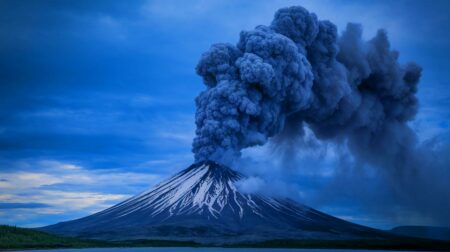| IN A NUTSHELL |
|
In a groundbreaking discovery that has captivated the scientific community, researchers have unearthed a 480-million-year-old sponge in China that has fundamentally altered our understanding of early reef ecosystems. This ancient sponge, identified as Lophiostroma leizunia, is not only the oldest Stromatoporoid sponge ever recorded but also represents a significant shift in the timeline of skeletal reef development. By pushing back the record of these reefs by 20 million years, this find has opened up new avenues for exploring the evolutionary history of Earth’s marine life.
The Oldest Building-Block Sponge on Record
The discovery of Lophiostroma leizunia in South China by an international team of scientists marks a pivotal moment in paleontology. As reported in the journal PNAS, this sponge has extended the fossil record of stromatoporoid sponges and the reefs they constructed by a significant 20 million years. These ancient creatures lived during the Paleozoic era, a time characterized by the emergence of the earliest animals on Earth. The Paleozoic, spanning from 541 to 252 million years ago, witnessed the rise of diverse marine ecosystems, and L. leizunia played a crucial role in shaping these environments.
What sets L. leizunia apart is its utilization of fluorapatite to construct its skeleton. This phosphate mineral, known for its glassy appearance in igneous rocks, was previously unheard of in sponges. The discovery that this group of organisms utilized all three major biominerals—silica, calcium carbonate, and calcium phosphate—offers scientists unprecedented insights into early reef-building strategies. This unique combination expands our understanding of biomineralization processes and highlights the genetic versatility of sponges during the Paleozoic era.
New Insights into Very Ancient History
The fossil-rich region of South China has long been a treasure trove of information about the Early Paleozoic marine ecosystems. The discovery of Lophiostroma leizunia adds a new chapter to this story, shedding light on a critical period in Earth’s history known as the Great Ordovician Biodiversification Event (GOBE). During this time, the planet experienced an explosion of marine biodiversity, with skeletal reefs emerging as a dominant feature.
The significance of this discovery lies in its ability to provide insights into the evolutionary dynamics of biomineralization and the emergence of metazoan-dominated reef ecosystems. By demonstrating that skeletal reefs developed much earlier than previously believed, L. leizunia offers a window into the complex interplay of environmental factors and evolutionary pressures that shaped early marine life. This breakthrough not only enriches our understanding of ancient life forms but also highlights the intricate web of interactions that have underpinned Earth’s biological history.
These decommissioned wind turbine blades transformed into asphalt are paving the roads of tomorrow
Biomineralization: A Genetic Blueprint for Success
The study of Lophiostroma leizunia has unveiled a remarkable aspect of early animal evolution: the use of diverse biomineralization strategies. By possessing a phosphatic skeleton, this sponge exemplifies the genetic toolkit that enabled early animals to explore novel ways of constructing their physical structures. This adaptability likely played a crucial role in the success and diversification of marine species during the Paleozoic era.
The presence of phosphatic skeletons in early stromatoporoids challenges previous notions about the evolution of reef-building organisms. It suggests that the genetic blueprint for diverse biomineralization strategies was present much earlier than scientists had assumed. This revelation not only deepens our understanding of the evolutionary processes that shaped ancient reefs but also underscores the importance of genetic innovation in the history of life on Earth.
The Global Impact of the Discovery
Beyond its scientific implications, the discovery of Lophiostroma leizunia has far-reaching consequences for our understanding of global biodiversity patterns. As scientists continue to explore the fossil-rich regions of South China, this find serves as a reminder of the untapped potential of Earth’s geological record. By piecing together the puzzle of ancient ecosystems, researchers can gain valuable insights into the processes that have shaped the planet’s biodiversity over millions of years.
This discovery also underscores the importance of preserving and studying fossil sites around the world. As we strive to understand the complexities of Earth’s history, it is essential to recognize the role of ancient life forms in shaping the planet’s ecological and evolutionary trajectories. The story of Lophiostroma leizunia is a testament to the enduring legacy of ancient organisms and their impact on the course of life’s history.
As we unravel the mysteries of ancient marine ecosystems, the discovery of Lophiostroma leizunia serves as a beacon of scientific exploration and curiosity. Its implications for the study of biomineralization and early reef development are profound, offering a glimpse into the dynamic processes that have shaped our planet. As scientists continue to decipher the secrets of Earth’s past, one question remains: What other hidden treasures lie buried in the depths of our planet’s history, waiting to rewrite the narrative of life on Earth?
Did you like it? 4.6/5 (23)









Wow, 480 million years is mind-blowing! 🕰️ How do they even date something that old?
This discovery is truly fascinating. Thank you for sharing!
Wait, sponges can build reefs? That’s news to me! 😮
How does this change our understanding of marine life evolution?
Can someone explain what biomineralization is in simpler terms?
Skeptical about the dating methods. How accurate are they really?
Lophiostroma leizunia sounds like a sci-fi character! 😂